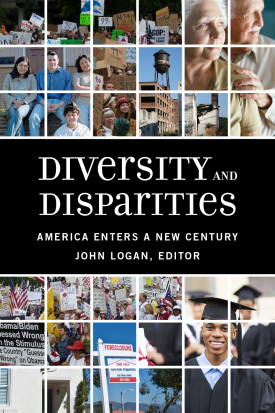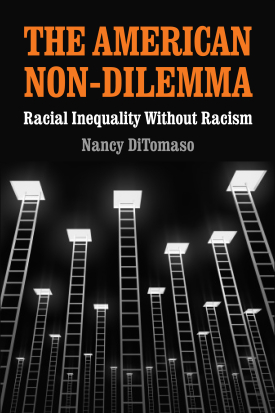
Diversity and Disparities
About This Book
The United States is more diverse than ever before. Increased immigration has added to a vibrant cultural fabric, and women and minorities have made significant strides in overcoming overt discrimination. At the same time, economic inequality has increased significantly in recent decades, and the Great Recession substantially weakened the economic standing not only of the poor but also of the middle class. Diversity and Disparities, edited by sociologist John Logan, assembles impressive new studies that interpret the social and economic changes in the U.S. over the last decade. The authors, leading social scientists from many disciplines, analyze changes in the labor market, family structure, immigration, and race. They find that while America has grown more diverse, the opportunities available to disadvantaged groups have become more unequal.
Drawing on detailed data from the decennial census, the American Community Survey, and other sources, the authors chart the growing diversity and the deepening disparities among different groups in the U.S. Harry J. Holzer and Marek Hlavac document that although the economy always rises and falls over the business cycle, the Great Recession of 2007–2009 was a catastrophic event that saw record levels of unemployment, especially among less-educated workers, young people, and minorities. Emily Rosenbaum shows how the Great Recession amplified disparities in access to home ownership, and demonstrates that young adults, especially African Americans, are falling behind previous cohorts not only in home ownership and wealth but even in starting their own families and households.
Sean F. Reardon and Kendra Bischoff explore the rise of class segregation as higher-income Americans are moving away from others into separate and privileged neighborhoods and communities. Immigration has also seen class polarization, with an increase in both highly skilled workers and undocumented immigrants. As Frank D. Bean and his colleagues show, the lack of a path to legal status for undocumented immigrants inhibits the educational and economic opportunities for their children and grandchildren. Barrett Lee and colleagues demonstrate that the nation and most cities and towns are becoming more diverse by race and ethnicity. However, while black-white segregation is slowly falling, Hispanics and Asians remain as segregated today as they were in 1980.
Diversity and Disparities raises concerns about the extent of socioeconomic immobility in the United States today. This volume provides valuable information for policymakers, journalists, and researchers seeking to understand the current state of the nation.
JOHN LOGAN is professor of sociology and director of the Research Initiative on Spatial Structures in the Social Sciences at Brown University.
CONTRIBUTORS: James D. Bachmeier, Frank D. Bean, Kendra Bischoff, John Bound, Susan K. Brown, Claudia Buchmann, Richard V. Burkhauser, Thomas A. DiPrete, Chad R. Farrell, Marek Hlavac, Harry J. Holzer, John Iceland, Jeff Larrimore, Mark A. Leach, Barrett A. Lee, John R. Logan, Zhenchao Qian, Sean F. Reardon, Emily Rosenbaum, Judith A. Seltzer, Michael A. Stoll, Sarah Turner, Jennifer Van Hook, Edward N. Wolff , Jenjira J. Yahirun
RSF Journal
View Book Series
Sign Up For Our Mailing List
Apply For Funding
Supplemental Award:
9/1/2012: $33,248
Over the past couple of decades we have seen a polarization of family formation patterns in the United States, with young adults with a four-year college degree waiting until after they are married to have children and young adults with only a high school education having children while unmarried. Research on marriage suggests that those in the less-advantaged education and income groups are as likely as others to want to marry, but that they do not feel sufficiently secure economically to make the commitment.
Between 1980 and 2004, the adjusted average compensation of a CEO at a large public corporation in the U.S. rose by 12.2% per year, from $625,000 to $9,840,000. Although the rise in CEO pay has flattened in the last few years, this dramatic rise has received extensive media, policy and academic attention. So far, scholarship on the rise in CEO pay has focused on two explanations: market forces and managerial power.
Economic inequality in the U.S. has increased dramatically in the last 30 years. Between 1979 and 2007, the top one percent of households claimed about 40% of the gains to overall income in the U.S., while the bottom 30% received only 0.4% of these gains. This drastic increase in inequality not only has economic and social implications, but implications for political inequality as well.
In 2004 and 2006, RSF supported a project led by Alejandro Portes to study ethnic and transnational organizations and their role in immigrant political incorporation in the U.S.

The American Non-Dilemma
About This Book
Winner of the 2013 C. Wright Mills Award from the Society for the Study of Social Problems
Winner of the 2014 Book Award from the Inequality, Poverty, and Mobility Section of the American Sociological Association
Runner Up, 2014 Academy of Management's George R. Terry Book Award
The Civil Rights movement of the 1960s seemed to mark a historical turning point in advancing the American dream of equal opportunity for all citizens, regardless of race. Yet 50 years on, racial inequality remains a troubling fact of life in American society and its causes are highly contested. In The American Non-Dilemma, sociologist Nancy DiTomaso convincingly argues that America's enduring racial divide is sustained more by whites' preferential treatment of members of their own social networks than by overt racial discrimination. Drawing on research from sociology, political science, history, and psychology, as well as her own interviews with a cross-section of non-Hispanic whites, DiTomaso provides a comprehensive examination of the persistence of racial inequality in the post-Civil Rights era and how it plays out in today's economic and political context.
Taking Gunnar Myrdal's classic work on America's racial divide, The American Dilemma, as her departure point, DiTomaso focuses on "the white side of the race line." To do so, she interviewed a sample of working, middle, and upper-class whites about their life histories, political views, and general outlook on racial inequality in America. While the vast majority of whites profess strong support for civil rights and equal opportunity regardless of race, they continue to pursue their own group-based advantage, especially in the labor market where whites tend to favor other whites in securing jobs protected from market competition. This "opportunity hoarding" leads to substantially improved life outcomes for whites due to their greater access to social resources from family, schools, churches, and other institutions with which they are engaged.
DiTomaso also examines how whites understand the persistence of racial inequality in a society where whites are, on average, the advantaged racial group. Most whites see themselves as part of the solution rather than part of the problem with regard to racial inequality. Yet they continue to harbor strong reservations about public policies—such as affirmative action—intended to ameliorate racial inequality. In effect, they accept the principles of civil rights but not the implementation of policies that would bring about greater racial equality. DiTomaso shows that the political engagement of different groups of whites is affected by their views of how civil rights policies impact their ability to provide advantages to family and friends. This tension between civil and labor rights is evident in Republicans' use of anti-civil rights platforms to attract white voters, and in the efforts of Democrats to bridge race and class issues, or civil and labor rights broadly defined. As a result, DiTomaso finds that whites are, at best, uncertain allies in the fight for racial equality.
Weaving together research on both race and class, along with the life experiences of DiTomaso's interview subjects, The American Non-Dilemma provides a compelling exploration of how racial inequality is reproduced in today's society, how people come to terms with the issue in their day-to-day experiences, and what these trends may signify in the contemporary political landscape.
NANCY DITOMASO is professor of organization management at Rutgers University.
RSF Journal
View Book Series
Sign Up For Our Mailing List
Apply For Funding
Pagination
- Previous page
- Page 49
- Next page
